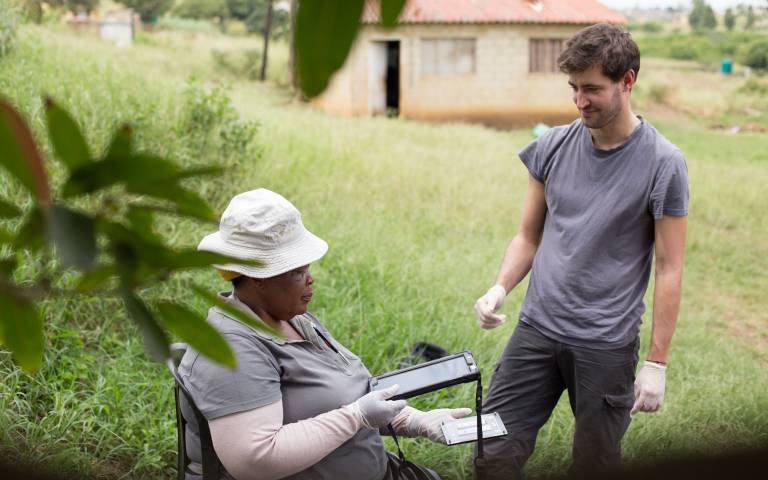创新背景
全世界每年进行的艾滋病毒检测超过1亿次,这意味着即使在质量保证方面稍有改进,也可能通过减少假阳性和假阴性的风险影响数百万人的生活。
创新过程
来自伦敦大学学院伦敦纳米技术中心和AHRI的学者使用深度学习(人工智能/AI)算法来提高卫生工作者在南非农村使用横向流动测试诊断艾滋病毒的能力。
通过利用手机传感器、摄像头、处理能力和数据共享能力的潜力,该团队开发了一款应用程序,可以读取终端用户在移动设备上拍摄的图像的测试结果。它还可以向公共卫生系统报告结果,以便更好地收集数据和持续护理。
在整个COVID-19大流行期间,侧流检测即快速诊断检测(RDTs)一直在使用,并在疾病控制和筛查中发挥着重要作用。
虽然它们提供了一种在临床环境之外的快速和简单的检测方法,包括自我检测,但对外行人来说,对检测结果的解释有时可能具有挑战性。
出于临床支持和监测目的,自我检测依赖于人们自我报告结果。证据表明,一些非专业护理人员可能因为色盲或近视而难以解释快速诊断。
这项新研究调查了人工智能应用程序是否可以支持现场工作人员、护士和社区卫生工作者做出的艾滋病毒检测决定。
该研究所由60多名训练有素的实地工作人员组成的团队首先利用伦敦大学学院开发的移动医疗工具和图像捕获协议,帮助建立了一个包含1.1万多张在南非夸祖鲁-纳塔尔省实地不同条件下拍摄的艾滋病毒检测图像的图书馆。

随后,伦敦大学学院的研究团队将这些图像作为机器学习算法的训练数据。他们比较了算法将图像分类为阴性或阳性的准确性,以及用户用眼睛解读测试结果的准确性。
首席作者兼i-sense主任Rachel McKendry教授(伦敦大学学院纳米技术中心和伦敦大学学院医学部)说:“这项研究与AHRI建立了强有力的合作关系,证明了使用深度学习成功分类‘真实世界’实地获取的快速测试图像的能力,并减少了用眼睛阅读测试结果时可能发生的错误数量。”这项研究表明,移动医疗工具可以对低收入和中等收入国家产生积极影响,并为未来更大规模的研究铺平了道路。”

一项针对5名经验各异的用户(从护士到新培训的社区卫生工作者)的试点实地研究让他们使用移动应用程序记录他们对40个艾滋病毒检测结果的解读,并捕捉检测结果的图片,由机器学习分类器自动读取。所有参与者都可以在没有培训的情况下使用该应用程序。
该机器学习分类器能够减少阅读RDT的错误,正确分类RDT图像的总体准确率为98.9%,而传统的肉眼判读测试的准确率为92.1%。此前对具有不同经验的用户解读HIV快速诊断试剂盒的研究显示,准确率在80%至97%之间不等。
快速诊断技术可支持的其他疾病包括疟疾、梅毒、结核病、流感和非传染性疾病。这项新研究调查了人工智能应用程序是否可以支持现场工作人员、护士和社区卫生工作者做出的艾滋病毒检测决定。
创新价值
这项技术使用深度学习成功分类‘真实世界’实地获取的快速测试图像的能力,并减少了用眼睛阅读测试结果时可能发生的错误数量。移动医疗工具可以对低收入和中等收入国家产生积极影响,并为未来更大规模的研究铺平了道路。
创新关键点
通过利用手机传感器、摄像头、处理能力和数据共享能力的潜力开发了一款应用程序,可以读取终端用户在移动设备上拍摄的图像的测试结果。它还可以向公共卫生系统报告结果,以便更好地收集数据和持续护理。
创新主体
伦敦大学学院(University College London,简称:UCL ),1826年创立于英国伦敦,是一所公立研究型大学,为伦敦大学联盟的创校学院、罗素大学集团和欧洲研究型大学联盟创始成员,被誉为金三角名校和“G5超级精英大学”之一。
UCL是伦敦的第一所大学,以其多元的学科设置著称,于REF 2014 英国大学官方排名中,位列全英之冠,享有最多的科研经费。UCL的医学、解剖学和生理学、建筑学、教育学、考古学、计算机科学、计算金融学等学科排名均位居世界前列,与LSE并称为“英国现代经济学研究的双子星”;其人文学院颁发的奥威尔奖则是政治写作界的最高荣誉。
Innovative AI applications help more accurately diagnose HIV
Academics from UCL London Centre for Nanotechnology and AHRI used deep learning (artificial intelligence /AI) algorithms to improve the ability of health workers to diagnose HIV using lateral mobility tests in rural South Africa.
By harnessing the potential of the phone's sensors, cameras, processing power, and data-sharing capabilities, the team developed an app that reads test results on images taken by end users on their mobile devices. It can also report results to the public health system for better data collection and continuity of care.
Side-flow tests, known as rapid diagnostic tests (RDTs), have been used throughout the COVID-19 pandemic and have played an important role in disease control and screening.
Although they provide a quick and easy test outside the clinical setting, including self-testing, interpretation of test results can sometimes be challenging for the layperson.
Self-testing relies on people self-reporting results for clinical support and monitoring purposes. Evidence suggests that some lay caregivers may have difficulty interpreting a rapid diagnosis because of color blindness or myopia.
The new study investigated whether AI apps could support HIV testing decisions made by field staff, nurses, and community health workers.
A team of more than 60 trained field workers at the institute first helped build a library of more than 11,000 HIV test images taken under different conditions in the field in KwaZulu-Natal, South Africa, using mobile health tools and image capture protocols developed at University College London.
The UCL team then used these images as training data for machine learning algorithms. They compared how well the algorithm classified images as negative or positive to how well users interpreted the test results with their eyes.
Lead author and Director of I-Sense, Professor Rachel McKendry (UCL Centre for Nanotechnology and UCL Medicine), said: "This study, in a strong partnership with AHRI, demonstrates the ability to use deep learning to successfully classify rapid test images acquired in the 'real world' field, And reduces the number of errors that can occur when reading test results by eye." This study shows that mhealth tools can have a positive impact in low - and middle-income countries and paves the way for larger studies in the future."
A pilot field study with five users of varying experience, ranging from nurses to newly trained community health workers, had them record their interpretation of 40 HIV test results using a mobile app and capture a picture of the test results to be automatically read by a machine learning classifier. All participants can use the app without training.
The machine learning classifier can reduce the error of reading RDT, and the overall accuracy of correctly classifying RDT images is 98.9%, while the accuracy of traditional visual interpretation test is 92.1%. Previous studies of interpreting rapid HIV diagnostic kits among users with varying experience have shown accuracy rates ranging from 80 to 97 percent.
Other diseases supported by rapid diagnostic techniques include malaria, syphilis, tuberculosis, influenza and noncommunicable diseases. The new study investigated whether AI apps could support HIV testing decisions made by field staff, nurses, and community health workers.
智能推荐
AI+动物科学 | 人工智能算法帮助追踪动物行为并识别情绪
2022-06-30创新人工智能系统算法,捕捉动物情绪和行为,帮助了解动物心理。
涉及学科涉及领域研究方向AI+材料化学 | 创新利用机器学习缩短测试电池材料的时间
2022-08-25麻省理工学院的研究人员利用机器学习工具,更快建立精确的计算机模型,帮助科学家缩减电池材料的测试时间。
涉及学科涉及领域研究方向结合人工智能驱动的智能监听设备守护自然森林
2022-06-30智能监听设备为地球的未来带来更多希望。通过收集和分析声音数据,它们也在彻底改变环境科学,即生物声学。生物声学,意味着研究人员通过人工智能可以更系统、更有效地监控和研究物种的行为和多样性。
涉及学科涉及领域研究方向AI+光学 | 新型隐私保护相机利用节能AI光速捕获所需物体
2022-11-10研究团队设计了一款智能相机,它只拍摄相关物体的照片,同时防止其他细节被捕获。
涉及学科涉及领域研究方向